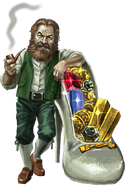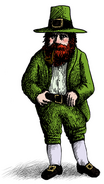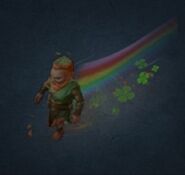A leprechaun (Irish Gaelic: leipreachán) is a fairy-like creature in Irish mythology. They are often mischievous creatures who spend their time making shoes or hiding away their coins in hidden pots of gold at the end of rainbows. Leprechauns may grant wishes to humans who capture them.
Myths & Legends[]
The earliest known reference to the leprechaun appears in the medieval tale known as the Echtra Fergus mac Léti (English: Adventure of Fergus son of Léti). The text contains an episode in which Fergus mac Léti, King of Ulster, falls asleep on the beach and wakes to himself being dragged into the sea by three "lúchorpáin". He captures his abductors, who grant him three wishes in exchange for release.
The leprechaun is said to be a solitary creature, whose principal occupation is making and mending shoes, and who enjoys practical jokes. According to Yeats, the great wealth of these fairies comes from the "treasure-crocks, buried of old in war-time", which they have uncovered and appropriated. According to McAnally the leprechaun is the son of an "evil spirit" and a "degenerate fairy" and is "not wholly good nor wholly evil".
Appearance[]
A leprechaun usually taking the form of an old man with red or white beard, clad in a red or green coat. Popular depiction shows the leprechaun as being no taller than a small child, with a beard and hat, sitting on a toadstool. However the leprechaun originally had a different appearance depending on where he was found. Before the 20th century, leprechauns were described as wearing red, as opposed to green. Samuel Lover, writing in 1831, describes the leprechaun as.
- "... quite a beau in his dress, notwithstanding, for he wears a red square-cut coat, richly laced with gold, and inexpressible of the same, cocked hat, shoes and buckles."
According to W. B. Yeats, the solitary fairies, like the leprechaun, wear red jackets, whereas the "trooping fairies" wear green. The leprechaun's jacket has seven rows of buttons with seven buttons to each row. On the western coast, he writes, the red jacket is covered by a frieze one, and in Ulster the creature wears a bicorne hat, and when he is up to anything unusually mischievous, he leaps on to a wall and spins, balancing himself on the point of the hat with his heels in the air.
According to McAnally,
- "He is about three feet high, and is dressed in a little red jacket or roundabout, with red breeches buckled at the knee, gray or black stockings, and a hat, cocked in the style of a century ago, over a little, old, withered face. Round his neck is an Elizabethan ruff, and frills of lace are at his wrists. On the wild west coast, where the Atlantic winds bring almost constant rains, he dispenses with ruff and frills and wears a frieze overcoat over his pretty red suit, so that, unless on the lookout for the cocked hat, ye might pass a Leprechawn on the road and never know it's himself that's in it at all."
Clothing Variations[]
This dress could vary by region, however. In McAnally's account there were differences between leprechauns or logherymans from different regions:
- The Northern Leprechaun or Logheryman wore a "military red coat and white breeches, with a broad-brimmed, high, pointed hat, on which he would sometimes stand upside down".
- The Lurigadawne of Tipperary wore an "antique slashed jacket of red, with peaks all round and a jockey cap, also sporting a sword, which he uses as a magic wand".
- The Luricawne of http://en.wikipedia.org/wiki/Kerry Kerry] was a "fat, pursy little fellow whose jolly round face rivals in redness the cut-a-way jacket he wears, that always has seven rows of seven buttons in each row".
- The Cluricawne of Monaghan wore "a swallow-tailed evening coat of red with green vest, white breeches, black stockings," shiny shoes, and a "long cone hat without a brim," sometimes used as a weapon.
In a poem entitled The Lepracaun; or, Fairy Shoemaker, 19th century Irish poet William Allingham describes the appearance of the leprechaun as:
- "...A wrinkled, wizen'd, and bearded Elf, Spectacles stuck on his pointed nose, Silver buckles to his hose, Leather apron — shoe in his lap..."
Origins[]
Some folk traditions hold that the leprechauns are descended from the Tuatha de Danann. When the Milesians came to Ireland they conquered the Tuatha de Danann and forced them to live under ground (this connects them to the Aos Sí).
Etymology[]
The word "leprechaun" is derived from the Irish Gaelic word "leipreachán". It is defined as "a pigmy, a sprite, or leprechaun" by Patrick Dinneen, the Irish historian, lexicographer and Gaelic revivalist. Further derivation is uncertain; the word may be a corruption of "luchrupán" (Middle Irish) from the Old Irish "luchorpán", itself a compoud of the root "lú" (small) and "corp" (body). The latter is derived from the Latin word "corpus" (body).
An alternative folk etymology proposes "leipreachán" is derived from "leithbrágan", a compound of "leith" (half) and "bróg" (brogue), linking it to the shoe-making profession of leprechauns.
Alternative spellings in English have included "lubrican", "leprehaun", and "lepreehawn". Some modern Irish books use the spelling "lioprachán".
Related creatures[]
The leprechaun is related to the clurichaun and the fear dearg in that he is a solitary creature. Some writers even go as far as to substitute these second two less well-known spirits for the leprechaun in stories or tales to reach a wider audience.




